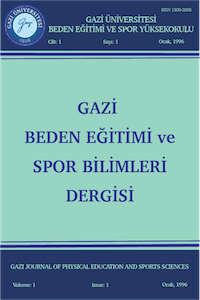Abstract
Bu çalışmanın amacı beden eğitimi öğretmenlerinin ders zaman yönetimi
davranışlarının ve tercih ettikleri öğretim yöntemlerinin belirlenmesidir. Ayrıca,
ders zaman yönetiminde cinsiyet, okul tipi, okul düzeyi farkları incelenmiştir.
Araştırmaya 30 beden eğitimi öğretmeni katılmıştır. Beden eğitimi öğretmenlerinin
dersleri videoya kayıt edilmiştir. Zaman yönetimi stratejileri "Ders
Süresi Zaman Yönetimi Analiz Formu" öğretim yöntemi tercihleri ise
"Mosston Öğretim Yöntemleri Yelpazesi Değerlendirme Formu" kullanılarak
video kayıtlarından analiz edilmiştir. İstatistiksel analiz için tanımlayıcı
istatistikler kullanılmıştır. Öğretmenlerin 40 dk’lık bir dersin ortalama 6.8
dk’sını teorik bilgi için, 8.1 dk’sını sınıf yönetimi ve organizasyonu için ve
ortalama 19.9 dk’sını fiziksel aktiviteler için kullandığı saptanmıştır.
Derslerde kullanılan öğretim yöntemlerinin ise % 82.9’unun alıştırma, % 14.2’sinin
komut, % 2.9’unun yönlendirilmiş buluş olduğu belirlenmiştir. Öğretmenlerin
cinsiyetlerinin, çalıştıkları okulun tipinin ve okul düzeyinin, ders zaman
yönetiminin hiçbir boyutunda farklılık yaratmadığı saptanmıştır (p > 0.05).
Sonuç olarak, bu çalışmada öğretmenlerin derslerinde sınıf yönetimi ve
organizasyonuna gereğinden fazla zaman ayırdıkları ve çok sınırlı sayıda öğretim
yöntemi kullandıkları görülmüştür. Hizmet içi eğitim çalışmalarında öğretmenlere
bu konularda eğitim verilmesi yararlı olacaktır.
References
- 1. Mosston, M., & Ashworth, S. (1994). Teaching in Physical Education. New York: MacMillan College Publishing Company.
- 2. Metzler, M. W. (1990). Instructional Supervision for Physical Education. Champaign, Human Kinetics.
- 3. ince, M. L., Ok, A. (2005). Moving Prospective Physical Education Teachers to Learner Centered Teaching: Can it be Stimulated in a Traditional Context? Journal of International Council for Health, Physical Education, Sport and Dance. XLI (1), 6-12.
- 4. Gensemer, R. E. (1991). Physical Education: Perspectives, Inquiry, Applications (2nd Ed.). United States: WM. C. Brown Publishers.
- 5. Siedentop, D., Mand, C., & Taggart, A. (1986). Physical Education: Teaching and Curriculum Strategies for Grades 5-12. Mountain View: Mayfield Publishing Company.
Abstract
The
purpose of this study was to describe time management strategies and teaching
style preferences of physical education teachers. In addition, effects of the
teachers’ gender, school type and school level on time management strategies
were analyzed. Thirty physical education teachers participated in this study.
Video recordings of physical education teachers were obtained during their
lessons. Time management strategies were analyzed using the "Time
Management Analysis Form", and teaching style preferences were analyzed using
"Mosston Spectrum of Teaching Style Checklist". Results indicated
that teachers used 6.8 min for the theoretical knowledge, 8.1 min for classroom
management and organization, and 19.9 min for physical activities in a 40-min
lesson. Teachers’ only preferred practice (82.9%), command (14.2%), and guided
discovery teaching methods (2.9%) in their lessons. Teachers’ gender, school
type or school level did not significantly affect the time management
strategies (p > 0.05). In conclusion, teachers spent too much time for the
classroom management and organization, and use very limited number of teaching
methods. In-service education programs for the teachers should include these issues.
References
- 1. Mosston, M., & Ashworth, S. (1994). Teaching in Physical Education. New York: MacMillan College Publishing Company.
- 2. Metzler, M. W. (1990). Instructional Supervision for Physical Education. Champaign, Human Kinetics.
- 3. ince, M. L., Ok, A. (2005). Moving Prospective Physical Education Teachers to Learner Centered Teaching: Can it be Stimulated in a Traditional Context? Journal of International Council for Health, Physical Education, Sport and Dance. XLI (1), 6-12.
- 4. Gensemer, R. E. (1991). Physical Education: Perspectives, Inquiry, Applications (2nd Ed.). United States: WM. C. Brown Publishers.
- 5. Siedentop, D., Mand, C., & Taggart, A. (1986). Physical Education: Teaching and Curriculum Strategies for Grades 5-12. Mountain View: Mayfield Publishing Company.
Details
| Subjects | Sports Medicine |
|---|---|
| Journal Section | Articles |
| Authors | |
| Publication Date | April 1, 2005 |
| Submission Date | March 10, 2005 |
| Acceptance Date | August 15, 2005 |
| Published in Issue | Year 2005 Volume: 10 Issue: 2 |
Gazi Journal of Physical Education and Sports Sciences is a scientific and peer-reviewed journal published quarterly.

